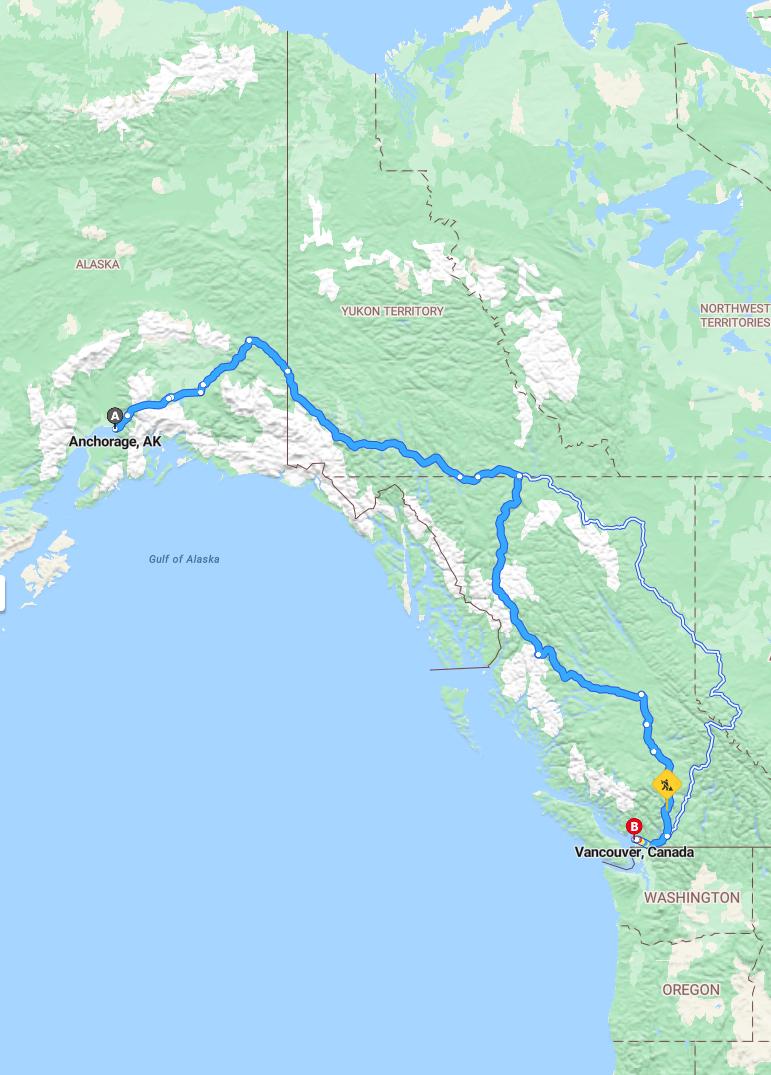Distance and estimated driving time
The drive from Anchorage to Vancouver covers approximately 2,195 miles and is estimated to take about 38 hours and 32 minutes. This route primarily follows the YT-1 and BC-37 highways, offering scenic views along the way. Travelers should plan accordingly for breaks and overnight stays to ensure a safe and comfortable journey. Proper preparation and checking current road conditions can help make the trip more efficient and enjoyable.
Driving route
Embarking on a road trip from Anchorage, Alaska to Vancouver, British Columbia offers a stunning journey through diverse landscapes and iconic destinations. The route begins in Anchorage, where travelers can enjoy the city's vibrant culture before heading southeast through the scenic wilderness of Alaska. Passing through Tok, travelers can experience the rugged beauty of the Alaskan frontier, followed by a stop in Whitehorse, the capital of Canada's Yukon Territory, known for its rich history and stunning natural surroundings. Continuing south, the journey leads to Stewart, a charming coastal town famous for its breathtaking scenery and proximity to Alaska's fjords. Finally, the trip concludes in Vancouver, a cosmopolitan city with spectacular views, vibrant neighborhoods, and numerous attractions, making it a memorable cross-border adventure.

Best time to travel from Anchorage to Vancouver
The optimal time to undertake the drive from Anchorage to Vancouver is during late spring through early fall, specifically from May to September, when weather conditions are generally milder and road conditions are more reliable. Traveling in this period ensures fewer disruptions caused by snow or ice, especially when passing through regions like Tok, Whitehorse, and Stewart, where winter travel can be challenging. Summer months also offer longer daylight hours, providing more time for sightseeing and safer driving. Conversely, winter travel poses risks due to snow storms and reduced visibility, making spring and early fall the best seasons for a safer, more enjoyable journey.
Road conditions and seasonal considerations
Traveling from Anchorage to Vancouver involves navigating a variety of road conditions and seasonal challenges. In colder months, especially winter, road surfaces can be icy or snow-covered, particularly around Tok, Whitehorse, and Stewart, requiring careful driving and vehicle preparedness. Seasonal variations also impact visibility and road maintenance, with spring and fall bringing increased chances of rain and potential landslides in mountainous areas. Travelers should stay informed about current weather forecasts and road advisories to ensure a safe journey across this diverse and scenic route.
Border crossing procedures and required documentation
When driving from Anchorage to Vancouver, travelers will cross international borders between the United States and Canada along the route. It is essential to carry valid travel documents such as passports or approved travel cards for all passengers, as these are required for entry into Canada and re-entry into the United States. Customs and border security may ask to inspect your vehicle and inquire about your travel plans, so having additional documentation like visas (if applicable), proof of insurance, and vehicle registration is advisable. Additionally, travelers should be prepared for possible delays at border crossings in Tok, Whitehorse, and Stewart, especially during peak times or for thorough security checks.
Estimated fuel costs and refueling stops
Driving from Anchorage to Vancouver covers approximately 2,200 miles, and estimating fuel costs depends on the vehicle's efficiency. Assuming an average fuel economy of 25 miles per gallon and a gas price of around $4.50 per gallon, the total fuel expense would be approximately $396. Along this journey, refueling stops are planned at key locations such as Tok, Whitehorse, Blogette, Stewart, and Vancouver, ensuring a safe and efficient trip. It's advisable to monitor fuel levels closely, especially through remote areas like Whitehorse and Stewart, where fuel availability may vary, to avoid any unexpected inconveniences.
Places of interest along the route
The journey from Anchorage to Vancouver offers a diverse array of scenic and cultural attractions. In Tok, travelers can explore local museums and enjoy the stunning Alaskan wilderness. Whitehorse, the capital of Yukon, features historic sites and vibrant arts scenes, perfect for cultural exploration. Continuing to Stewart, visitors can experience breathtaking fjords, lush rainforests, and the famous Fish Creek Wildlife Observation Site, culminating in the dynamic city of Vancouver with its beautiful waterfront, Stanley Park, and eclectic neighborhoods.
Accommodation options en route
Travelers driving from Anchorage to Vancouver have a variety of accommodation options along the route, ranging from cozy hotels and motels to scenic lodges and campgrounds. In Tok, visitors can find budget-friendly motels and guesthouses suitable for a quick overnight stay. Whitehorse offers a wider selection, including comfortable hotels, inns, and even some boutique accommodations for those seeking a more luxurious experience. As you approach Vancouver, options include well-known hotel chains and boutique hotels in nearby towns, providing a comfortable base to explore the region.
Traffic and weather forecast updates
When driving from Anchorage to Vancouver, it is essential to stay updated on traffic and weather conditions, as they can vary significantly across the route. Fog, snow, or rain may impact visibility and road safety, especially in remote areas like Tok, Whitehorse, and Stewart. Regularly checking live traffic reports and weather forecasts helps drivers plan for potential delays and ensure a safe journey. Staying informed through navigation apps and local updates can make the trip smoother and more enjoyable.
Safety tips for cross-border driving
When driving cross-border from Anchorage to Vancouver, ensuring safety is paramount. Before setting out, verify that all travel documents, vehicle registration, and insurance are up to date and readily accessible. Stay informed about current road conditions, weather forecasts, and any border entry requirements or restrictions. Additionally, maintain a safe driving speed, keep a well-stocked emergency kit, and stay alert to local traffic laws to ensure a smooth and secure journey through diverse terrains and jurisdictions.
